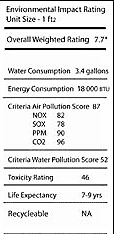By Jason F. Mclennan, & Peter Rumsey
One of the most frequently asked questions in the sustainable design world is how to tell whether or not a material is “green” in comparison to other potential choices. This question arises for just about every type of material used in buildings, from paint to shingles. It goes to the heart of the issue of “what is sustainable?” The answer should be simple, yet it isn’t. A clear and comprehensive format for describing a material’s environmental attributes would greatly benefit the industry and the environment.
The primary method for evaluating a material’s relationship to the environmental is called life cycle analysis (LCA). There is no dominant consensus standard, but most approaches are generally similar. They encompass a product’s life cycle from extraction or harvesting through processing and manufacture to use and ultimate disposal or recycling. LCA practitioners must decide where to draw boundaries for analysis, what impacts are considered, and how they are described or quantified.
This approach is not standard practice in the marketplace. There is no requirement or tradition that compels manufacturers to comprehensively assess their products, nor to release the data if they do. Most producers know little about the environmental consequences of how customers use their materials, or about upstream suppliers’ activities. Even if a company diligently measures the flow of energy, water, chemicals and materials in their process, most are unwilling to share this information with the general public, so as to guard trade secrets or to limit liability.
Even where relevant information is available, using it for materials selection can be like comparing apples and oranges. Methodologies and metrics vary. Assessing and ranking the relative import of potential effects is often qualitative or subjective. In many cases, even the self-proclaimed “experts” are doing little more than making educated guesses based on a variety of indicators and partial information.
To make it more complicated, a material that may be environmentally benign in one situation might in fact be detrimental in another, if improperly used. For example, it might be possible to specify recycled content insulation that has fewer VOCs and has a lower embodied energy than a conventional product, but if it has a lower R-value than a competing petrochemical product it may result in greater environmental impact over time. Operating energy use usually exceeds embodied energy many times over.
Green design experts often have to weigh the trade-offs of a multitude of factors in order to make a decision, and in doing so impart their own biases. An interesting example is the debate over which refrigerant is preferable, HCFC-123 or HFC-134a. HCFC-123 contributes more to ozone depletion, but enables more efficient chiller operation that reduces energy use and therefore greenhouse gas emissions. HFC-134a has far lower ozone impacts, but has 100 times the global warming potential of HCFC-123. One is regulated by the Montreal Protocol and the other by the Kyoto Protocol. How do you know which is more critical? Is global warming more serious than ozone depletion? Are small risks to human health more important than large impacts on specific ecosystems or other species? Who decides?
These challenges are widely acknowledged, but have not deterred valuable contributions by a growing list of individuals and groups. Government-regulated Materials Safety Data Sheets (MSDS) provide invaluable basic information. The American Institute of Architect’s Environmental Resource Guide provides a remarkably thorough compilation of the environmental aspects of scores of materials. The National Institute of Science and Technology continues to develop an LCA tool called BEES. Environmental Building News has done an exemplary job evaluating products and describing the complex issues surrounding materials specification. The Athena Institute in trying to bring more hard science to the tough job of material selection. Many other approaches and tools are available, most with a relatively narrow focus. Leadership in Energy and Environmental Design (LEED) provide some synthesis, incorporating materials-specific standards such as Forest Stewardship Council certification for sustainably-harvested wood and Carpet and Rug Institute VOC emissions limits, or defining its own criteria for recycled content or regional sourcing.
Yet these efforts are insufficient to the task of compiling comprehensive, concise environmental information in a compact, user-friendly format. You shouldn’t have to be an LCA expert in order to know which material to specify with confidence. We shouldn’t have to rely on guesswork to know if a material might be harmful to a chemically sensitive person. We shouldn’t have to wonder where exactly our materials came from and if its use endangers the biosphere or natural resources or squanders energy and water.
Sound impossible? Consider the everyday examples on the supermarket shelves. Healthy food and water is arguably the only human material need more important than shelter (other than air). In principle, if the food industry can list ingredients and report nutritional information economically, than so too can the building industry, provided that there is a practical standard. In the future, products that contain potential carcinogens, mutagens or other hazards to humans and the ecosystem should be clearly marked with the equivalent of the surgeon general’s warning on a pack of cigarettes. Each product should come with the equivalent of a nutritional label that fully describes the most important environmental and health impacts of the material’s use through time. Labels should enable apples-to-apples comparisons between products. We shouldn’t have to all be experts to make the right decisions, just educated consumers.
We all have a critical role to play in demanding better information from suppliers. Each stakeholder in building design, construction, operation and occupancy has a stake in how our industry addresses these vital issues. Manufacturers should be responsible for providing the public with accurate data and full disclosure. The best practices of information design should help package this information in the most accessible way. This goal should be balanced with economic factors, and that creation and implementation should be as easy and inexpensive as possible. Give the market full information, and let the market choose what to use in the built environment.
The U.S. Green Building Council provides perhaps the leading example of an industry transforming itself through stakeholder collaboration to create a consensus voluntary standard. A truly representative coalition created the LEED framework based on existing best practices and accepted standards to define what makes a “green” building. In effect the marketplace self-organized, and responded rapidly and vigorously without a government mandate.
LEED’s successful adoption is well recognized. Perhaps this model offers a way forward for integrating the best work so far, and creating a usable framework for green materials analysis and selection. This will not be easy, and won’t happen overnight, but the long-term health of the human and natural environment depend on it.
++++
Jason F. McLennan is a nationally recognized leader in the Sustainable Design Movement and is the founder and Director of Elements the sustainable consulting division of BNIM Architects based in Kansas City. Contact him: JMclennan@bnim.com
Peter Rumsey, PE, CEM is an emerging leader in engineering design for sustainable buildings whose work has earned national recognition. He is founder and President of Rumsey Engineers, Inc., in Oakland, Calif. Contact him: prumsey@rumseyengineers.com
FROM Environmental Design + Construction Magazine, a SustainableBusiness.com Content Partner
***
Nutrition Label diagram is from The Philosophy of Sustainable Design by Jason F. McLennan, published by Ecotone Publishing. All rights reserved.
